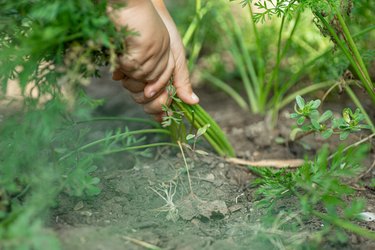Seeing a beautiful butterfly fluttering around in your backyard is a delightful experience. It's no wonder someone would want more of them around to observe. Being able to witness the miracle that is the transformation from caterpillar to chrysalis right before your eyes without having to leave your yard is something that can't be bought.
With a little planning, you can attract a variety of butterflies to your garden. By taking the right steps, like selecting the correct plants and making your yard a thriving environment for butterflies, you can have a continuous cycle of eggs, caterpillars and butterflies right in your backyard.
Video of the Day
Video of the Day
Butterflies are most commonly seen from spring through late summer, but you can start planning your garden at any time of the year. The placement of plants, the accents you choose for your garden and even the way you care for the plants all make a huge difference in how attractive your yard is going to be to butterflies.
Make your garden irresistible to all kinds of butterflies, from colorful monarchs to swallowtails and every kind in between. Before long, your yard will be a buzzing community for butterflies.
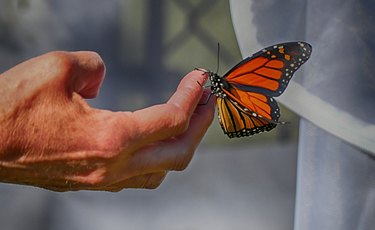
1. Opt for Native Plants
When you visit the garden center and start to select plants for your butterfly garden, it can be intimidating to decide which ones will look best. There are a ton of varieties from which to choose. The best plants for your butterfly garden are the ones that are native to your area.
Native plants and flowers will be the ones to which the butterflies and helpful pollinators in your area are naturally attracted. Do a little research on native plants in your area before you head to the store so you don't have to waste any time or money. If you still aren't sure which ones to choose, just visit your local plant nursery and speak with one of the many knowledgeable experts who can guide you in the right direction.

2. Select a Variety of Colorful Flowers
When it comes time to choose which flowering plants will grace your garden, besides making sure all the plants are native, be sure to select the ones with the brightest blooms. The bright colors will be sure to attract the most butterflies.
Flowers like marigolds, zinnias and aster are all brightly colored and are ones that butterflies love. Hollyhocks and thistle plants both have tall, colorful flowers that will add some height to your garden. Any of these will be a good nectar source and will be nice to behold as well. They're also all relatively easy to maintain, so they are great for beginner gardeners. Just try to keep your color palette to one or two colors instead of choosing a few of each color offered at your local garden center.
The reason for this is because when butterflies are flying by, they are searching for bright-colored flowers that will likely be full of pollen and nectar. Help the butterflies and group bunches of similarly colored flowers instead of spreading them out around the garden. Butterflies don't have the best eyesight, so putting the same colors together will help get their attention since they are searching for the largest, brightest bunch of flowers on which to land.

3. Leave Out Pieces of Fruit
The next time you are cutting fruit, be sure to save a few pieces for your flighty friends. They don't need much more than a few small pieces. Butterflies love sipping the sweet nectar from a variety of food sources, including fruits like oranges, mangoes, strawberries and watermelon — the juicier, the better. Some butterflies actually prefer when it starts to rot.
They even like bananas since they get ripe and soft. So, don't be so quick to toss out those mushy, speckled bananas on your kitchen counter. Whichever fruit you decide to share, just be sure to change it out on a daily basis to keep unwanted critters and bugs out of the way.
If ants become a problem, just add a small amount of water to the dish, or you can make your own hanging butterfly feeder that has room for the fruit and space for the butterflies to safely land while they have lunch.

4. Remove Bird Feeders From the Area
It's not the best idea to place your bird feeder right next to your carefully selected flowers and expect butterflies to still flock to your garden. All types of birds may see the caterpillars and butterflies and think they're a delicious snack. That is the opposite of what you want.
Any birds in the area, including small hummingbirds, will cause the butterflies to fly away and pick a new spot or a new yard entirely that they deem safer. Instead of having to watch your precious butterflies and caterpillars get gobbled up by hungry birds, just separate the two areas. If possible, put one in your backyard and the other in the front to be safe.
Butterflies will be reluctant to stop for a drink or to lay their precious eggs in a potentially dangerous area. So, place your bird feeder as far away from your butterfly garden as possible to ensure a happy and harmonious yard.
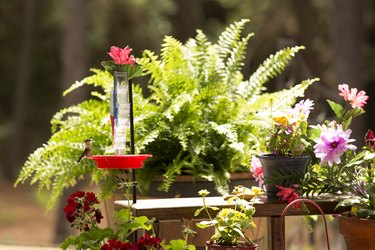
5. Include Caterpillar Host Plants Too
Sure, a yard full of butterflies is the goal, but let's not forget about what they are before they become beautiful butterflies. Having caterpillars in your yard is almost a surefire way to ensure there are also butterflies. Besides, being able to witness the metamorphosis from caterpillar to butterfly in your own yard is a magical experience.
Plants like butterfly bush, fennel and goldenrod are all plants that butterflies and caterpillars alike love to be around. Some butterflies will only stop to lay eggs on a specific plant, though. Take monarch butterflies, for example. They lay their eggs exclusively on the milkweed plant since that is what the larvae will eat until they mature and form their chrysalis. Their entire life cycle, from egg all the way to butterfly, will happen on the milkweed plant.

6. Avoid Pesticides
Keeping your plants and flowers free from harmful pesticides is big when it comes to attracting butterflies to your yard. Since butterflies typically lay eggs on the plants their offspring will eat to survive, if your plants are all covered with pesticides, that is what the young caterpillars will ingest.
Caterpillars who feast on pesticide-covered plants become full of disease. The sick caterpillars may not be able to form their chrysalis properly, and there's a chance they could emerge with crinkled wings or not emerge at all. Those that make it to the butterfly stage will go on to lay eggs that are also diseased, and the cycle begins all over again. So, it's best to avoid them.
An easy and safe way to get rid of most unwanted bugs on your plants is to spray them with a simple mixture of gentle dish soap and water a few times a day.

7. Incorporate Flat Stones for Resting
Butterflies aren't much different from the rest of us — they love a good rest. Since they need to be warm before flying away, flat rocks are a great place for them to get a pre-flight warm up. Rocks hold heat much better than soil, so they are an important component in any thriving butterfly garden.
Easily incorporate large, flat rocks into your garden design by using them for things like borders, a pathway or just a fun accent. The butterflies will flock to your yard and will thank you for your thoughtful design.
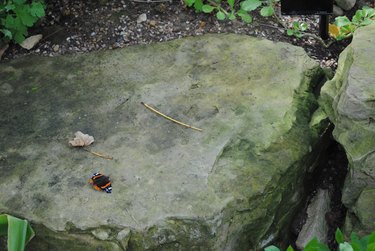
8. Make Sure There's Lots of Sunlight
We all know that sunlight is crucial in making a garden grow, but it's also crucial if you want to attract a variety of butterflies to your yard. Be sure to watch your garden at different hours throughout the day to ensure there is plenty of full sun. Remove or trim any bushes or tree branches that cast a shadow over your space.
Not only will this help your flowering plants grow but it will make it easier for passing butterflies to spot your yard. Since butterflies need to be warm to fly, they'll be able to hang out in your yard longer if it is sunny. Ample amounts of sunshine are also helpful for the caterpillars and the eggs, and it helps them develop faster.
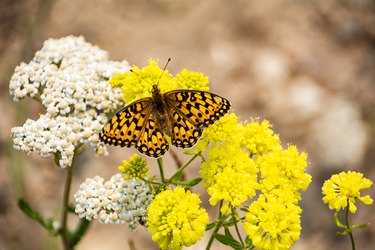
9. Add a Small Tray With Water and Soil to Encourage Puddling
Adult butterflies need water to survive, but they don't typically drink from things like lakes, rivers and puddles. Instead, they prefer to find a damp spot in the dirt and drink from there since they will also absorb minerals from the ground. This act is called "puddling."
You can make an irresistible puddling station in your garden with a few items you probably already have at home. Start by taking a shallow dish and mixing coarse sand, dirt and a little water and placing it in an easily accessible area. You can even give your puddling dish an upgrade by adding a little extra salt to the mixture. This will give the soil extra minerals that all butterfly species love so much.
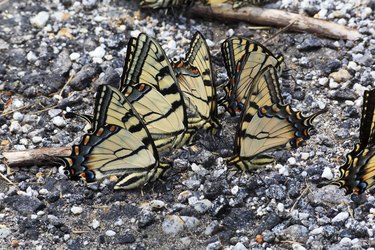
10. Don't Overprune Your Garden
It may be tempting to trim and pull any weed that pops up in your garden, which is understandable after you spent so much time on it. However, it's important to resist the urge. The weeds and the wildflowers offer crucial protection for eggs, caterpillars and even the butterflies themselves. The ground-covering weeds in your garden are the perfect place for tiny baby caterpillars to spend their first few days of life. It also helps to camouflage them from potential predators, like lizards and birds.
Butterflies and caterpillars actually prefer your garden when it's a bit overgrown. If you just can't stand the sight of an unkempt garden, consider sectioning off a small area that you refrain from pruning. Butterflies don't need much space, but they'll appreciate every inch.
